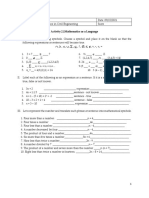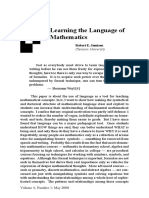Golden Ratio
Golden Ratio
Uploaded by
Nor AmiraCopyright:
Available Formats
Golden Ratio
Golden Ratio
Uploaded by
Nor AmiraOriginal Description:
Copyright
Available Formats
Share this document
Did you find this document useful?
Is this content inappropriate?
Copyright:
Available Formats
Golden Ratio
Golden Ratio
Uploaded by
Nor AmiraCopyright:
Available Formats
Golden ratio
The golden section is a line segment divided according to the golden ratio: The total length a + b is to the longer segment a as a is to the shorter segment b. In mathematics and the arts, two quantities are in the golden ratio if the ratio of the sum of the quantities to the larger quantity is equal to (=) the ratio of the larger quantity to the smaller one. The golden ratio is an irrational mathematical constant, approximately 1.6180339887. Other names frequently used for the golden ratio are the golden section (Latin: sectio aurea) and golden mean. Other terms encountered include extreme and mean ratio, medial section, divine proportion, divine section (Latin: sectio divina), golden proportion, golden cut, golden number, and mean of Phidias. The golden ratio is often denoted by the Greek letter phi, usually lower case (). The figure on the right illustrates the geometric relationship that defines this constant. Expressed algebraically:
This equation has as its unique positive solution the algebraic irrational number
[1]
At least since the Renaissance, many artists and architects have proportioned their works to approximate the golden ratioespecially in the form of the golden rectangle, in which the ratio of the longer side to the shorter is the golden ratio believing this proportion to be aesthetically pleasing. Mathematicians have studied the golden ratio because of its unique and interesting properties. What is the Golden Ratio? The Golden Ratio is a unique number, approximately 1.618033989. It is also known as the Divine Ratio, the Golden Mean, the Golden Number, and the Golden Section. Its unique mathematical properties have resulted in a very long and influential history.
What is the Fibonacci Sequence of Numbers? The Fibonacci numbers are a unique sequence of integers, starting with 1, where each element is the sum of the two previous numbers. For example: 1, 1, 2, 3, 5, 8, 13, 21, 34, 55, 89, etc. Relationship Between the Fibonacci Sequence and the Golden Ratio The Fibonacci Sequence is an infinite sequence, which means it goes on for ever, and as it develops, the ratio of the consecutive terms converges (becomes closer) to the Golden Ratio, ~1.618. For example, to find the ratio of any two successive numbers, take the latter number and divide by the former. So, we will have: 1/1=1, 2/1=2, 3/2=1.5, 5/3=1.66, 8/5=1.6, 13/8=1.625, 21/13=1.615. The History of the Golden Ratio Phi (Golden Ratio) as a mysterious number has been discovered in many places, such as art, architectures, humans, and plants. You might wonder where and when Phi first appeared? Who was the discoverer? According the history of mathematics, Phi was first understood and used by the ancient mathematicians in Egypt, two to three thousand years ago, due to its frequent appearance in Geometry. Phidias (500BC-432 BC), a Greek sculptor and mathematician, studied Phi and used the Phi in many designs of his sculptures, such as the statue of the goddess Athena in Athena, and the state of god Zeus in Olympiad. And Euclid Alexandria (365BC300BC) had once described the Phi as "dividing a line in the extreme and mean ratio" in his Book VI of Elements. The name " Golden Ratio" appears in the form sectio aurea (Golden Section in Greek) by Leonardo da Vinci (1452-1519) who used this the Golden ratio in many of his masterpieces, such as The Last Supper and Mona Lisa. In 1900s, an Maerican mathematician named Mark Barr, represented the Golden Ratio by using a greek symbol . The Golden Ratio and Beauty in Nature Plant Growth What kind of relationship do Fibonacci Numbers and plants have? The process of the growing plant follows the Fibonacci numbers, from the first shoot, to the two shoots, three shoots, and five shoots, and eight shoots, and on and on. The branching rates in plants occur in the Fibonacci pattern, where the first level has one "branching" (the trunk), the second has two branches, than 3, 5, 8, 13 and so on. Also, the spacing of leaves around each branch or stalk spirals with respect to the Golden Ratio.
Flowers On the back of the passiflora incarnate, the 3 sepals (the part of the flower that is not the petal) that protected the bud are outermost, followed by the 5 outer green petals and an inner layer of 5 more paler green petals. In the front, 5 greenish, Tshaped stamens are gathered in the center, followed by the 3 deep brown carpels and styvle branches. Petal Counts The petals of the different flowers also contain the Fibonacci Numbers. The examples are that the buttercup has 5 petals, delphiniums has 8 petals, ragwort has 13 petals, aster as 21 petals, plantain has 34 petals, and asteraceae family has 55 petals, and some of them have 89 petals. The Golden Ratio and Beauty in Architecture The Golden Ratio has appeared in ancient architecture. The examples are many, such as the Great Pyramid in Giza, Egypt which is considered one of the Seven World Wonders of the ancient world, and the Greek Parthenon that was constructed between 447 and 472BC. Not only did the ancient Egyptians and Greeks know about the magic of Golden Ratio, so did the Renaissance artists, who used the Golden Ratio in the design of Notre Dame in between the 12th and 14th centuries. Some modern architecture are also influenced by Golden Ratio as well, such as the United Nations Building. The origins of the divine proportion In the Elements, the most influential mathematics textbook ever written, Euclid of Alexandria (ca. 300 BC) defines a proportion derived from a division of a line into what he calls its "extreme and mean ratio." Euclid's definition reads: A straight line is said to have been cut in extreme and mean ratio when, as the whole line is to the greater segment, so is the greater to the lesser. In other words, in the diagram below, point C divides the line in such a way that the ratio of AC to CB is equal to the ratio of AB to AC. Some elementary algebra shows that in this case the ratio of AC to CB is equal to the irrational number 1.618 (precisely half the sum of 1 and the square root of 5).
C divides the line segment AB according to the Golden Ratio
In mathematical terms, the sequence Fn of Fibonacci numbers is defined by the recurrence relation
with seed values
Fibonacci's Rabbits The original problem that Fibonacci investigated (in the year 1202) was about how fast rabbits could breed in ideal circumstances. Suppose a newly-born pair of rabbits, one male, one female, are put in a field. Rabbits are able to mate at the age of one month so that at the end of its second month a female can produce another pair of rabbits. Suppose that our rabbits never die and that the female always produces one new pair (one male, one female) every month from the second month on. The puzzle that Fibonacci posed was... How many pairs will there be in one year?
1. At the end of the first month, they mate, but there is still one only 1 pair. 2. At the end of the second month the female produces a new pair, so now there are 2 pairs of rabbits in the field. 3. At the end of the third month, the original female produces a second pair, making 3 pairs in all in the field. 4. At the end of the fourth month, the original female has produced yet another new pair, the female born two months ago produces her first pair also, making 5 pairs.
The number of pairs of rabbits in the field at the start of each month is 1, 1, 2, 3, 5, 8, 13, 21, 34, ... Can you see how the series is formed and how it continues? If not, look at the answer! The first 300 Fibonacci numbers are here and some questions for you to answer. Now can you see why this is the answer to our Rabbits problem? If not, here's why. Another view of the Rabbit's Family Tree:
Both diagrams above represent the same information. Rabbits have been numbered to enable comparisons and to count them, as follows: All the rabbits born in the same month are of the same generation and are on the same level in the tree. The rabbits have been uniquely numbered so that in the same generation the new rabbits are numbered in the order of their parent's number. Thus 5, 6 and 7 are the children of 0, 1 and 2 respectively.
The rabbits labelled with a Fibonacci number are the children of the original rabbit (0) at the top of the tree. There are a Fibonacci number of new rabbits in each generation, marked with a dot. There are a Fibonacci number of rabbits in total from the top down to any single generation. There are many other interesting mathematical properties of this tree that are explored in later pages at this site. 0, 1, 1, 2, 3, 5, 8, 13, 21, 34, 55, 89, 144, 233, 377, 610, 987 ..More..
The Rabbits problem is not very realistic, is it? It seems to imply that brother and sisters mate, which, genetically, leads to problems. We can get round this by saying that the female of each pair mates with any male and produces another pair. Another problem which again is not true to life, is that each birth is of exactly two rabbits, one male and one female.
You might also like
- Mathematics in The Modern World TransesDocument6 pagesMathematics in The Modern World Transesrentachin18No ratings yet
- Gec 006 ReviewerDocument6 pagesGec 006 ReviewerLEARSI ISRAELNo ratings yet
- (HCI) HumanDocument50 pages(HCI) Humanmahi omaimaNo ratings yet
- Exer 9 LeavesDocument3 pagesExer 9 LeavesColleen Dejan100% (1)
- Introduction To Fibonacci SeriesDocument16 pagesIntroduction To Fibonacci SeriesnavtejNo ratings yet
- Tongue TwisterDocument1 pageTongue TwisterNor AmiraNo ratings yet
- Tongue TwisterDocument1 pageTongue TwisterNor AmiraNo ratings yet
- Chapter 1 Patterns in Nature 2Document12 pagesChapter 1 Patterns in Nature 2Kristelle Ann Hilario CaballeroNo ratings yet
- MMW Reviewer MidtermsDocument6 pagesMMW Reviewer MidtermsCarreon ChristianNo ratings yet
- The Language of Relations and FunctionsDocument13 pagesThe Language of Relations and FunctionsAvril Llagas100% (1)
- Sets 1Document55 pagesSets 1Kim Abigelle GarciaNo ratings yet
- Golden Ratio in ArchitectureDocument6 pagesGolden Ratio in ArchitectureSaru AroraNo ratings yet
- Cavite State University: WWW - Cvsu.edu - PHDocument8 pagesCavite State University: WWW - Cvsu.edu - PHIan Mateo VelascoNo ratings yet
- Chapter 1 - Art and Nature of ArtDocument6 pagesChapter 1 - Art and Nature of ArtArthur LeywinNo ratings yet
- Mathematics in Our WorldDocument19 pagesMathematics in Our WorldisidroNo ratings yet
- CHAPTER 5 - Environmental Awareness and ProtectionDocument17 pagesCHAPTER 5 - Environmental Awareness and Protectionkella shrimpNo ratings yet
- Nature in NumbersDocument59 pagesNature in NumbersRalph Laurence G VisayaNo ratings yet
- UTS Student Copy 2021Document105 pagesUTS Student Copy 2021Rachel Anne BodlisNo ratings yet
- MMW LecturesDocument5 pagesMMW LecturesJohn Rancel MulinyaweNo ratings yet
- MMW Quiz 3 de La Cruz Leona Jean ADocument7 pagesMMW Quiz 3 de La Cruz Leona Jean AVangie GuevarraNo ratings yet
- Activities For Module 1 (BSA I-1)Document7 pagesActivities For Module 1 (BSA I-1)Maureen FloresNo ratings yet
- LAGUNA COPPER PLATE INSCRIPTION - Summary and InterpretationDocument3 pagesLAGUNA COPPER PLATE INSCRIPTION - Summary and InterpretationAra Lourise RustriaNo ratings yet
- A - Chapter 1 Mathematics in Our WorldDocument49 pagesA - Chapter 1 Mathematics in Our WorldBrian GarciaNo ratings yet
- Mathematics in The Modern WorldDocument2 pagesMathematics in The Modern WorldPalua, Danica Faye MagbanuaNo ratings yet
- Power Point in Pattern in NatureDocument16 pagesPower Point in Pattern in Naturemanuel posasNo ratings yet
- Module 2 Section 1 Lecture SlidesDocument35 pagesModule 2 Section 1 Lecture SlidesJewela NogasNo ratings yet
- Gec Math (Mathematics in The Modern World)Document53 pagesGec Math (Mathematics in The Modern World)Madeline Castro Pangilinan100% (1)
- Activity 5 - Linear ProgrammingDocument6 pagesActivity 5 - Linear ProgrammingChristal FALAMENo ratings yet
- Midterm Reviewer ModmathDocument9 pagesMidterm Reviewer ModmathAaron AbareNo ratings yet
- Module I (Geec 107)Document57 pagesModule I (Geec 107)Marooning ManNo ratings yet
- ART APPRECIATION Lesson 4Document3 pagesART APPRECIATION Lesson 4charity villanuevaNo ratings yet
- 04-Patterns in NatureDocument30 pages04-Patterns in Nature아맇No ratings yet
- Activity 2.1 MMWDocument1 pageActivity 2.1 MMWJ Saint BadeNo ratings yet
- Engineering Drowing Chapter 3Document10 pagesEngineering Drowing Chapter 3DT artNo ratings yet
- MMW Worksheet 1.2 - The Fibonacci and The Golden RatioDocument14 pagesMMW Worksheet 1.2 - The Fibonacci and The Golden RatioZoren Divina Borreta100% (1)
- Fractals: Pointed Star)Document3 pagesFractals: Pointed Star)Dayne LNo ratings yet
- Module 2 STSDocument29 pagesModule 2 STSSergio III Matuguinas VillablancaNo ratings yet
- Pioneers of CalculusDocument7 pagesPioneers of CalculusRonaldNo ratings yet
- MMW Prelim Homework 3Document6 pagesMMW Prelim Homework 3Jan Rae MarianoNo ratings yet
- Ex. 2. Egg As A Thickening and Gelling AgentDocument4 pagesEx. 2. Egg As A Thickening and Gelling AgentMA. NECOLE JEREMIAH GONZALESNo ratings yet
- Mapúa Institute of Technology National Service Training Program Civic Welfare Training Service (Mapúa-Cwts) Student'S ModuleDocument58 pagesMapúa Institute of Technology National Service Training Program Civic Welfare Training Service (Mapúa-Cwts) Student'S ModuleJayson AbadNo ratings yet
- Kartilya NG KatipunanDocument7 pagesKartilya NG KatipunanJumar RanasNo ratings yet
- Medium of ArtDocument13 pagesMedium of ArtEdlyn ResuelloNo ratings yet
- The Nature of Mathematics: Natural PatternsDocument12 pagesThe Nature of Mathematics: Natural PatternsEldrich CustodioNo ratings yet
- Introduction To Art Appreciation: Educational Objectives of The ChapterDocument8 pagesIntroduction To Art Appreciation: Educational Objectives of The ChapterJerome MosadaNo ratings yet
- John Dela Cruz - GECMAT Section 1 AssignmentDocument5 pagesJohn Dela Cruz - GECMAT Section 1 AssignmentJohn DelacruzNo ratings yet
- Module - Sts PrelimDocument16 pagesModule - Sts PrelimNeilEdwardOrolaCalidaNo ratings yet
- Chapter I. Nature of Mathematics: Mathematics in Our WorldDocument28 pagesChapter I. Nature of Mathematics: Mathematics in Our WorldBrian Andrei CasabayNo ratings yet
- Mathematics in NatureDocument9 pagesMathematics in NatureAngelEncarnacionCorralNo ratings yet
- GED Lesson Exercise 2 - GONZALESDocument3 pagesGED Lesson Exercise 2 - GONZALESAdolph Christian GonzalesNo ratings yet
- GEd 102 Module 2Document47 pagesGEd 102 Module 2Jisung ParkNo ratings yet
- GE 1 - Understanding The SelfDocument18 pagesGE 1 - Understanding The SelfMARLYN GUIANGNo ratings yet
- Colegio de San Gabriel Arcangel of Caloocan, IncDocument7 pagesColegio de San Gabriel Arcangel of Caloocan, IncKIRITO SALINASNo ratings yet
- Learning The Language of MathematicsDocument10 pagesLearning The Language of MathematicsM2C7r6No ratings yet
- 1.1 Patterns in NatureDocument10 pages1.1 Patterns in NatureKris CruzNo ratings yet
- Nature of Mathematics MathworldDocument20 pagesNature of Mathematics MathworldFrida Galliguez33% (3)
- ArtDocument8 pagesArtAlvin Naire Patacsil100% (1)
- Understanding The Self ReviewerDocument5 pagesUnderstanding The Self ReviewerRin ChesterNo ratings yet
- Lesson 1 Self From Various PerspectivesDocument44 pagesLesson 1 Self From Various PerspectivesJay Villegas0% (1)
- GEC 4 Unit 1 Lesson 3-4Document31 pagesGEC 4 Unit 1 Lesson 3-4Paul John Panganiban100% (1)
- Introduction in MMWDocument27 pagesIntroduction in MMWmarcosgio90No ratings yet
- The Golden RatioDocument9 pagesThe Golden Ratioapi-301548909No ratings yet
- Second Language AcquisitionDocument2 pagesSecond Language AcquisitionNor AmiraNo ratings yet
- ISL WEEK 1 (I) & (Iii) WIDADocument9 pagesISL WEEK 1 (I) & (Iii) WIDANor AmiraNo ratings yet
- Grammar Translation MethodDocument1 pageGrammar Translation MethodNor AmiraNo ratings yet
- Dividing by 10: Can You Use The Calculator To Help You Learn How To Divide by 100?Document1 pageDividing by 10: Can You Use The Calculator To Help You Learn How To Divide by 100?Nor AmiraNo ratings yet
- Week 2Document5 pagesWeek 2Nor AmiraNo ratings yet
- Academic Essay: Knowing How To Live AloneDocument8 pagesAcademic Essay: Knowing How To Live AloneNor AmiraNo ratings yet
- Why Save Endangered Specie1Document2 pagesWhy Save Endangered Specie1Nor AmiraNo ratings yet
- Week 2Document5 pagesWeek 2Nor AmiraNo ratings yet
- III HarmerDocument5 pagesIII HarmerNor AmiraNo ratings yet
- Cut and Paste The Animals From The Brochure. Write The Phrase For Each Animals Pasted and You Can Use The Words Given in The BoxDocument4 pagesCut and Paste The Animals From The Brochure. Write The Phrase For Each Animals Pasted and You Can Use The Words Given in The BoxNor AmiraNo ratings yet
- Group Members: 1. Amar Safwan 2. Nor Amira 3. Bendly Roy: Strengths WeaknessesDocument3 pagesGroup Members: 1. Amar Safwan 2. Nor Amira 3. Bendly Roy: Strengths WeaknessesNor AmiraNo ratings yet
- Tick (/) For The Right Answer: Conjunctions Exercise 1Document11 pagesTick (/) For The Right Answer: Conjunctions Exercise 1Nor AmiraNo ratings yet
- III HarmerDocument5 pagesIII HarmerNor AmiraNo ratings yet
- Write Four Sentences About The Animal in Space Provided. You Are Given 5 Minutes To Complete This TaskDocument1 pageWrite Four Sentences About The Animal in Space Provided. You Are Given 5 Minutes To Complete This TaskNor AmiraNo ratings yet
- AbacusDocument41 pagesAbacusNor AmiraNo ratings yet









































































